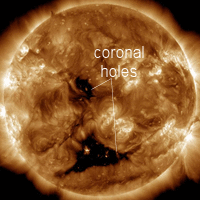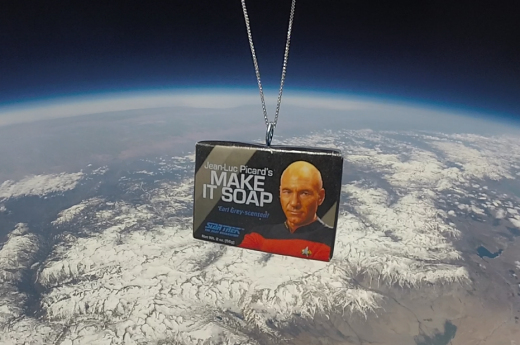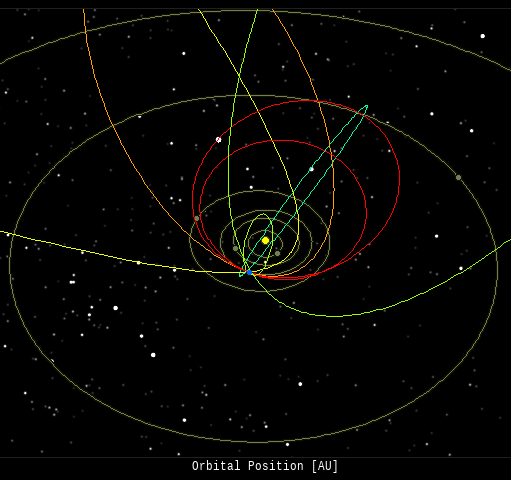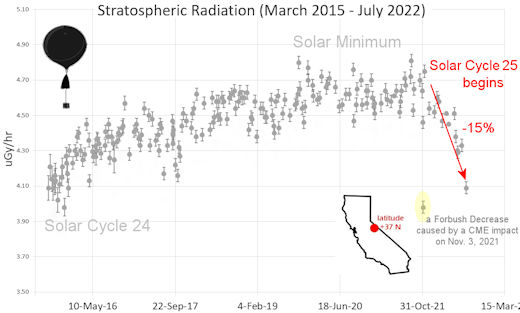 | | | Switch to: Europe, USA, New Zealand, Antarctica Credit: NOAA/Ovation  Planetary K-index Planetary K-index
Now: Kp= 2.67 quiet
24-hr max: Kp= 3.00 quiet
explanation | more data
Interplanetary Mag. Field
Btotal: 7.83 nT
Bz: -6.13 nT south
more data: ACE, DSCOVR
Updated: Today at 1146 UT  Coronal Holes: 31 May 23 Coronal Holes: 31 May 23 
Solar wind flowing from this pair of coronal holes could reach Earth on June 2-4. Credit: SDO/AIA  Noctilucent Clouds Noctilucent Clouds
Bad news: NASA's AIM spacecraft, which monitors noctilucent clouds, may be dead due to problems with an onboard battery. Mission controllers have not yet given up all hope, so stay tuned. Switch view:Ross Ice Shelf, Antarctic Peninsula, East Antarctica, Polar Updated May31  SPACE WEATHER
NOAA Forecasts | | Updated at: 2023 May 31 2200 UTC FLARE | 0-24 hr | 24-48 hr | CLASS M | 40 % | 40 % | CLASS X | 10 % | 10 % |  Geomagnetic Storms: Geomagnetic Storms:
Probabilities for significant disturbances in Earth's magnetic field are given for three activity levels: active, minor storm, severe storm Updated at: 2023 May 31 2200 UTC Mid-latitudes | 0-24 hr | 24-48 hr | ACTIVE | 10 % | 40 % | MINOR | 05 % | 25 % | SEVERE | 01 % | 05 % | High latitudes | 0-24 hr | 24-48 hr | ACTIVE | 15 % | 10 % | MINOR | 20 % | 25 % | SEVERE | 15 % | 65 % | | | |  | | | | | | | | | | | Text created by ChatGPT and other Large Language Models is spreading rapidly across the Internet. It's well-written, artificial, frequently inaccurate. If you find a mistake on Spaceweather.com, rest assured it was made by a real human being. This is an AI Free Zone! | | | MINOR GEOMAGNETIC STORM WATCH: NOAA forecasters say that minor G1-class geomagnetic storms are possible on June 2nd when a stream of solar wind is expected to hit Earth's magnetic field. The gaseous material is flowing from a pair of holes in the sun's atmosphere. Aurora alerts: SMS Text POLLEN CORONAS: Something in the air is making the sun over Finland look unusual. "It's pollen," says Mikko Peussa, who photographed the phenomenon on May 30th from the city of Turku near the Baltic Sea: 
The air is sparkling and the sun is surrounded by pastel rings. These are called "pollen coronas," caused by sunlight scattered from swarms of pollen in the air. The "sparkles" in Peussa's photo are some of the individual grains. "The pollen is coming from pine trees in the area," says Peussa. Springtime cones are opening, spreading pollen so that pines can reproduce. Individual grains are very tiny, with optical properties that produce compact, intensely colored pastel rings. 
Above: Pine pollen seen through a microscope [more]
Viewed through a microscope, pine pollens look like Mickey Mouse ears. The ears are air sacs, which act like little sails for riding on the wind. Air currents naturally align the "mouse ears" in the same direction. This is why pollen coronas tend to be elliptical, not circular. Got pines? The sun over your head might look unusual, too. Submit your photos here. Realtime Space Weather Photo Gallery
Free: Spaceweather.com Newsletter FAR-OUT FATHER'S DAY GIFT: Have you ever wished your dad smelled like Jean-Luc Picard? Make it Soap! Scented like Earl Grey tea, this bar of soap flew to the stratosphere on May 26, 2023, onboard an Earth to Sky Calculus cosmic ray balloon:

You can have it for $99.95. The students of Earth to Sky are selling space soap to support their cosmic ray ballooning program. Each bar comes with a greeting card showing the soap in flight and telling the story of its journey to the stratosphere and back again. Far Out Gifts: Earth to Sky Store
All sales support hands-on STEM education
Realtime Aurora Photo Gallery
Free: Spaceweather.com Newsletter Every night, a network of NASA all-sky cameras scans the skies above the United States for meteoritic fireballs. Automated software maintained by NASA's Meteoroid Environment Office calculates their orbits, velocity, penetration depth in Earth's atmosphere and many other characteristics. Daily results are presented here on Spaceweather.com. On May 31, 2023, the network reported 7 fireballs.
(7 sporadics)  In this diagram of the inner solar system, all of the fireball orbits intersect at a single point--Earth. The orbits are color-coded by velocity, from slow (red) to fast (blue). [Larger image] [movies] Potentially Hazardous Asteroids ( PHAs) are space rocks larger than approximately 100m that can come closer to Earth than 0.05 AU. None of the known PHAs is on a collision course with our planet, although astronomers are finding new ones all the time. On May 31, 2023 there were 2335 potentially hazardous asteroids.
 | Recent & Upcoming Earth-asteroid encounters: | Asteroid | Date(UT) | Miss Distance | Velocity (km/s) | Diameter (m) | | 2023 KZ | 2023-May-26 | 8.9 LD | 4.4 | 13 | | 2023 KB2 | 2023-May-26 | 11.9 LD | 7.3 | 22 | | 2023 KX | 2023-May-26 | 16 LD | 15.9 | 30 | | 2023 KC3 | 2023-May-26 | 11.6 LD | 10.5 | 19 | | 2023 KF | 2023-May-26 | 17.9 LD | 8 | 44 | | 2023 KK4 | 2023-May-27 | 0.9 LD | 17.9 | 11 | | 2023 JE2 | 2023-May-27 | 19.7 LD | 11.4 | 35 | | 2023 KU4 | 2023-May-27 | 0.8 LD | 7.2 | 8 | | 2023 KL1 | 2023-May-27 | 9.1 LD | 6.2 | 18 | | 2023 KW3 | 2023-May-28 | 3.5 LD | 7 | 9 | | 2023 KX3 | 2023-May-28 | 2.6 LD | 3.1 | 25 | | 2023 KQ4 | 2023-May-28 | 6.1 LD | 9.7 | 18 | | 2023 KU2 | 2023-May-28 | 2.8 LD | 14.7 | 13 | | 2023 KV2 | 2023-May-28 | 6.7 LD | 9.3 | 23 | | 2023 JZ3 | 2023-May-28 | 14.2 LD | 4.1 | 25 | | 2023 KV3 | 2023-May-29 | 1.2 LD | 11.1 | 8 | | 2021 KO2 | 2023-May-29 | 15.8 LD | 13.9 | 9 | | 2023 JZ4 | 2023-May-29 | 6 LD | 16.1 | 34 | | 2023 KT4 | 2023-May-30 | 8.1 LD | 8.1 | 17 | | 2023 KT1 | 2023-May-30 | 10 LD | 7.8 | 23 | | 2012 KP24 | 2023-May-31 | 10.3 LD | 12.4 | 19 | | 2023 KE5 | 2023-Jun-01 | 5.9 LD | 8.5 | 25 | | 2023 JM1 | 2023-Jun-01 | 10.1 LD | 5.1 | 23 | | 2023 KZ2 | 2023-Jun-02 | 12.4 LD | 9.3 | 20 | | 2023 KS2 | 2023-Jun-02 | 10.3 LD | 10.3 | 22 | | 2023 JE5 | 2023-Jun-04 | 17.6 LD | 8 | 34 | | 2023 JR2 | 2023-Jun-04 | 17 LD | 7.6 | 39 | | 2023 HO18 | 2023-Jun-04 | 1.2 LD | 4.7 | 32 | | 2023 KW2 | 2023-Jun-06 | 11.8 LD | 10.1 | 61 | | 2018 KR | 2023-Jun-07 | 6.5 LD | 4.9 | 19 | | 2017 UJ2 | 2023-Jun-07 | 5.3 LD | 5.6 | 2 | | 2023 JB3 | 2023-Jun-09 | 14.2 LD | 7 | 50 | | 488453 | 2023-Jun-12 | 8.3 LD | 21.5 | 495 | | 2022 WN4 | 2023-Jun-13 | 10.8 LD | 15.1 | 158 | | 2020 DB5 | 2023-Jun-15 | 11.3 LD | 9.5 | 506 | | 2023 HL | 2023-Jun-17 | 13.5 LD | 1 | 15 | | 2016 LK49 | 2023-Jun-19 | 17.4 LD | 19.4 | 22 | | 2023 HF1 | 2023-Jun-21 | 12.5 LD | 4.4 | 59 | | 467336 | 2023-Jun-24 | 17.4 LD | 7.1 | 269 | | 2008 LG2 | 2023-Jun-24 | 10.5 LD | 5.6 | 32 | | 2013 WV44 | 2023-Jun-28 | 9.1 LD | 11.8 | 95 | | 2022 MM1 | 2023-Jun-29 | 9.5 LD | 9.8 | 41 | | 2020 NC | 2023-Jul-02 | 13.9 LD | 7.7 | 123 | | 2023 HO6 | 2023-Jul-05 | 5.3 LD | 7.8 | 244 | | 2019 LH5 | 2023-Jul-07 | 14.9 LD | 21.6 | 281 | | 2018 NW | 2023-Jul-10 | 18 LD | 21.8 | 10 | | 2018 UY | 2023-Jul-12 | 7.4 LD | 16.4 | 243 | | 2020 UQ3 | 2023-Jul-18 | 3.2 LD | 9.3 | 59 | | 2022 GX2 | 2023-Jul-20 | 11.9 LD | 9.4 | 5 | | 2020 OM | 2023-Jul-20 | 8.5 LD | 9.5 | 14 | | 2015 MA54 | 2023-Jul-24 | 16.6 LD | 9.2 | 31 | | 2018 BG5 | 2023-Jul-27 | 10.7 LD | 8.4 | 56 | | 2020 PP1 | 2023-Jul-29 | 17 LD | 4.1 | 17 | Notes: LD means "Lunar Distance." 1 LD = 384,401 km, the distance between Earth and the Moon. 1 LD also equals 0.00256 AU. | | Cosmic Rays in the Atmosphere | SPACE WEATHER BALLOON DATA: Almost once a week, Spaceweather.com and the students of Earth to Sky Calculus fly space weather balloons to the stratosphere over California. These balloons are equipped with sensors that detect secondary cosmic rays, a form of radiation from space that can penetrate all the way down to Earth's surface. Our monitoring program has been underway without interruption for 7 years, resulting in a unique dataset of in situ atmospheric measurements. Latest results (July 2022): Atmospheric radiation is decreasing in 2022. Our latest measurements in July 2022 registered a 6-year low: 
What's going on? Ironically, the radiation drop is caused by increasing solar activity. Solar Cycle 25 has roared to life faster than forecasters expected. The sun's strengthening and increasingly tangled magnetic field repels cosmic rays from deep space. In addition, solar coronal mass ejections (CMEs) sweep aside cosmic rays, causing sharp reductions called "Forbush Decreases." The two effects blend together to bring daily radiation levels down. .Who cares? Cosmic rays are a surprisingly "down to Earth" form of space weather. They can alter the chemistry of the atmosphere, trigger lightning, and penetrate commercial airplanes. According to a study from the Harvard T.H. Chan school of public health, crews of aircraft have higher rates of cancer than the general population. The researchers listed cosmic rays, irregular sleep habits, and chemical contaminants as leading risk factors. A number of controversial studies (#1, #2, #3, #4) go even further, linking cosmic rays with cardiac arrhythmias and sudden cardiac death. Technical notes: The radiation sensors onboard our helium balloons detect X-rays and gamma-rays in the energy range 10 keV to 20 MeV. These energies span the range of medical X-ray machines and airport security scanners. Data points in the graph labeled "Stratospheric Radiation" correspond to the peak of the Regener-Pfotzer maximum, which lies about 67,000 feet above central California. When cosmic rays crash into Earth's atmosphere, they produce a spray of secondary particles that is most intense at the entrance to the stratosphere. Physicists Eric Regener and Georg Pfotzer discovered the maximum using balloons in the 1930s and it is what we are measuring today. | | The official U.S. government space weather bureau | | | The first place to look for information about sundogs, pillars, rainbows and related phenomena. | | | Researchers call it a "Hubble for the sun." SDO is the most advanced solar observatory ever. | | | 3D views of the sun from NASA's Solar and Terrestrial Relations Observatory | | | Realtime and archival images of the Sun from SOHO. | | | information about sunspots based on the latest NOAA/USAF Active Region Summary | | | current counts of failed and deployed Starlink satellites from Jonathan's Space Page | | | Authoritative predictions of space junk and satellite re-entries | | | from the NOAA Space Environment Center | | | fun to read, but should be taken with a grain of salt! Forecasts looking ahead more than a few days are often wrong. | | | from the NOAA Space Environment Center | | | the underlying science of space weather |  | Getting YouTube comments is essential if you want to beat the algorithm! That’s why you need to buy YouTube comments from RealSocialz.com because they offer real USA comments you can customize. |  | BestCSGOGambling is the best site for everything related to CSGO gambling on the web | | | These links help Spaceweather.com stay online. Thank you to our supporters! | | | | | | | | |  | |  |   | ©2021 Spaceweather.com. All rights reserved. This site is penned daily by Dr. Tony Phillips. | |

